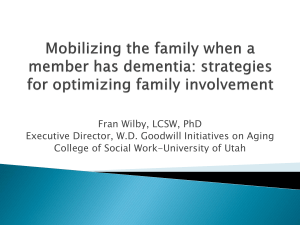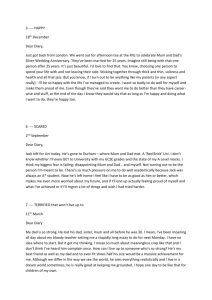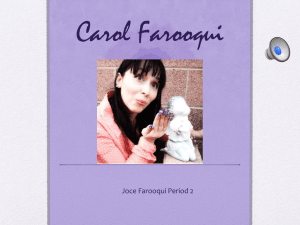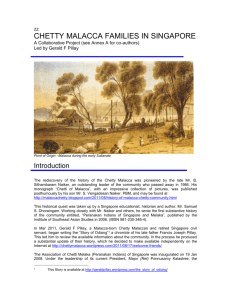chapter-one-beginnings-3
advertisement
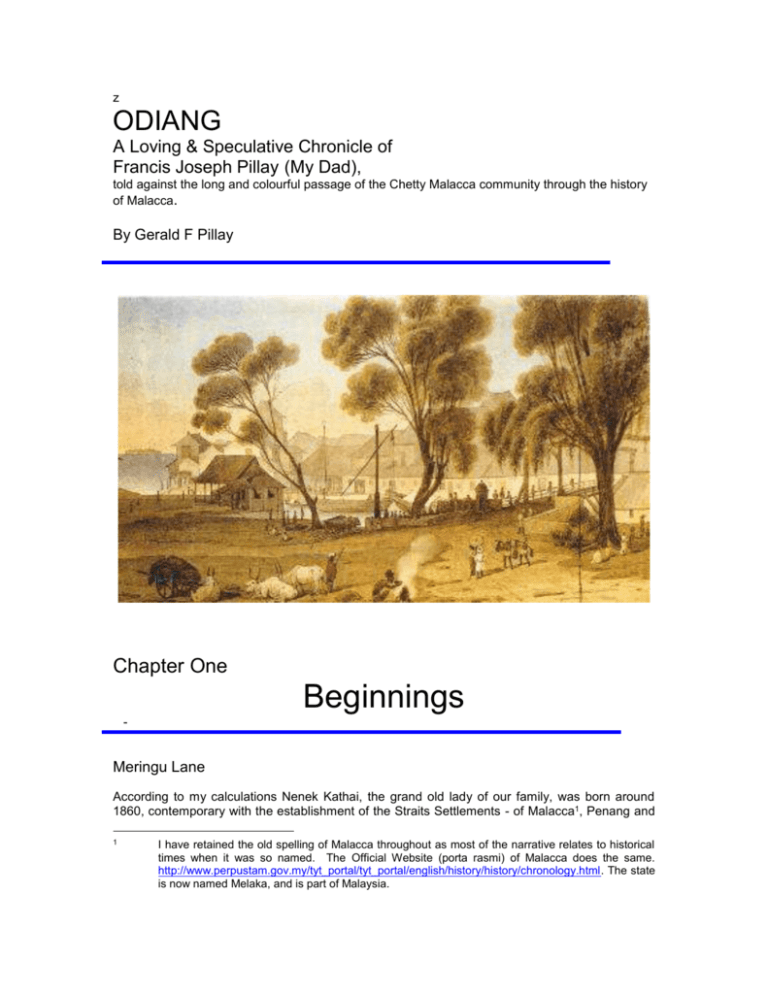
z ODIANG A Loving & Speculative Chronicle of Francis Joseph Pillay (My Dad), told against the long and colourful passage of the Chetty Malacca community through the history of Malacca. By Gerald F Pillay Chapter One Beginnings - Meringu Lane According to my calculations Nenek Kathai, the grand old lady of our family, was born around 1860, contemporary with the establishment of the Straits Settlements - of Malacca1, Penang and 1 I have retained the old spelling of Malacca throughout as most of the narrative relates to historical times when it was so named. The Official Website (porta rasmi) of Malacca does the same. http://www.perpustam.gov.my/tyt_portal/tyt_portal/english/history/history/chronology.html. The state is now named Melaka, and is part of Malaysia. Odiang: Chapter One – Beginnings 2 Singapore. We know nothing of her parents or indeed of her husband, only that she had two daughters and lived at No 7 Meringu Lane Tranquerah2, which for purposes of this chronicle was the family seat. Her elder daughter, whose name again remains unforgivably unknown, must have been born in the early 1880s and was married to Sangaran Pillay in the late 1890s. They had only one child, my Dad, born on 23 Dec 1900. According to the senior relatives, Dad’s mother, my grand-mother, passed away either at child-birth or soon after, and my Dad was brought up by and under the thumb of Nenek Kathai. By all accounts, she did a fine job of it. His name was Odiang, and so he was known by all the elders and contemporaries in the community. When I appeared on the scene I was, proudly, “Anak Odiang”. Dad’s mother’s sister was named Letchimy3 @ Periachi. Again, according to my calculations, she would have been born in the 1890s. She married in the second decade of the new century to the great Suppiah Sundrum Pillay, only son of Mak Bola, who lived at 10 Meringu Lane. He was known in the community as Mamat, and outside the community as “Inche Mamat”. By my further reckonings, Periachi was barely in her teens and not yet married when her sister gave birth to Dad. So she must have been living with Nenek Kathai and my Dad. It is safe to presume that Nenek Kathai lived and saw her younger daughter married before she died, which would have been not earlier that around the mid 1920s, when she would have been past 60. There is an as yet unconfirmed story that both Nenek Kathai and Mak Bola were connected in common to a family in Tranquerah. When they moved to Meringu Lane cannot be established for the present. It is safe to assume that Mamat and wife moved into his home at 10 Meringu Lane, directly across the lane, on marriage. And Dad had completed secondary school. My Dad would at this point probably have been working, and might have already established roots in alternative accommodation When my Dad, my mum and I lived for a short while with them, around 1943 following our own vicissitudes during the Japanese Occupation, I sized up their children as follows: daughter Paparthi, 26, eldest son Sanasee 18, daughter Ponoi 17, son Kandan (14), daughter Batak, 13, son Krishna 12 and son Banian 9. At 9, I slotted in just ahead of Banian in the pecking order. At this point my Dad was 43, pretty senior to his first cousins, and was married and had a son. Periachi would have been in her early fifties and her husband I recall was in his late 50s. Paparthi married around 1944, after we made our appearance. It was my first wedding and the first in their family. The children addressed my Dad as “Aneng” , which is elder brother. The family lived at No 10 Meringu Lane from then on until last year, over 90 years and four generations, when the land was finally acquired for re-development. My Grand-father: the “Gary-man” My grand-father, Sangaran Pillay, was a gary operator by trade. That’s all we know. Say he was 25 when Dad was born, he would himself have been born in 1875, and married my grand-mother in the late 1890s. “Gary” was the street term used to describe a closed carriage for up to 8 persons pulled by a horse with the driver sitting in front. The word is not found in the Oxford or Webster dictionary, nor indeed on the Internet except as someone’s name, oddly enough someone connected with the carriage transport business. We have no information of my grandseigneur’s birthday or when he passed away and surmise that he and my grand-mother lived with Nenek Kathai, at least while the latter was alive. 2 I have likewise consistently used the old names of countries, districts, suburbs and streets, adopting the spellings I grew up with in the latter cases. 3 She was through out her life known by her family as Periachi. No one seems to remember any other name. But I distinctly recall that my own mother called and referred to her in conversations as Letchimy. This could be a corruption or improper pronunciation. Let this remain a matter to be cleared up in due course. For this narrative I shall use Periachi. Odiang: Chapter One – Beginnings 3 I remember the last garies operating during the war and in the immediate post war years. One service started from Limbongan beyond Tranquerah. Another operated from the Malacca General Hospital in Peringgit. The third, as I recall, started from Ujong Pasir. They converged at the Big Market (Pasar Besar) off Bunga Raya, which acted as the interchange. In their day, the garies provided essential cross-town services, mainly for family groups on visits to relatives or to the hospital. Soon after the war, they were replaced by the Malacca Town Bus Service. For close town-side or neighbourhood travel, there was of course the ever-dependable rickshaw. You usually found them waiting in a line under a road-side tree. You only had to call out “betcha”, and one of them would trot over. A Chinese importation, these were two-seater rattan armchairs with space at the legs for a third small person, and a hood for protection against the sun or rain. They were elevated on large wheels and attached with two long handles forward on the either side, between which the “rickshaw puller” would run hauling his passengers along. The latter were burly Chinese of incredible strength and endurance, deeply tanned and perpetually bathed in sweat. When they had to go upslope, it was an all mighty effort, but the passengers never thought of getting down. They uniformly wore a huge circular rattan hat, of about three feet in diameter, with a pointed top hat like a Mongol warrior. They used old motorcar tyres, cut into strips, under their feet to protect them from the heat and friction. When resting, they invariably smoked their pipes. .When two or more families went to church on Sunday by rickshaw, the small children (third passengers) would yell and urge the rickshaw pullers to race against one another. The rickshaw slipped into history, with the coming of the trishaw. . In Malacca, we called them “taxis”. They could go the distances of the gary, and in practice made the town bus redundant. To this day they are to be seen about, mainly for sight-seeing in the “old quarters” of town and joyrides for tourists. So, my grand-father was a very much part of the urban transportation scene of colonial Malacca. We have to hope he lived to experience the first impulses of modernisation. He may well have seen the first bicycle and car in town. I like to think that while he continued to stay at Nenek Kathai’s and perhaps after, he supported the family and my Dad’s schooling from his gary earnings, until he disappeared into the mists of history. * * *



